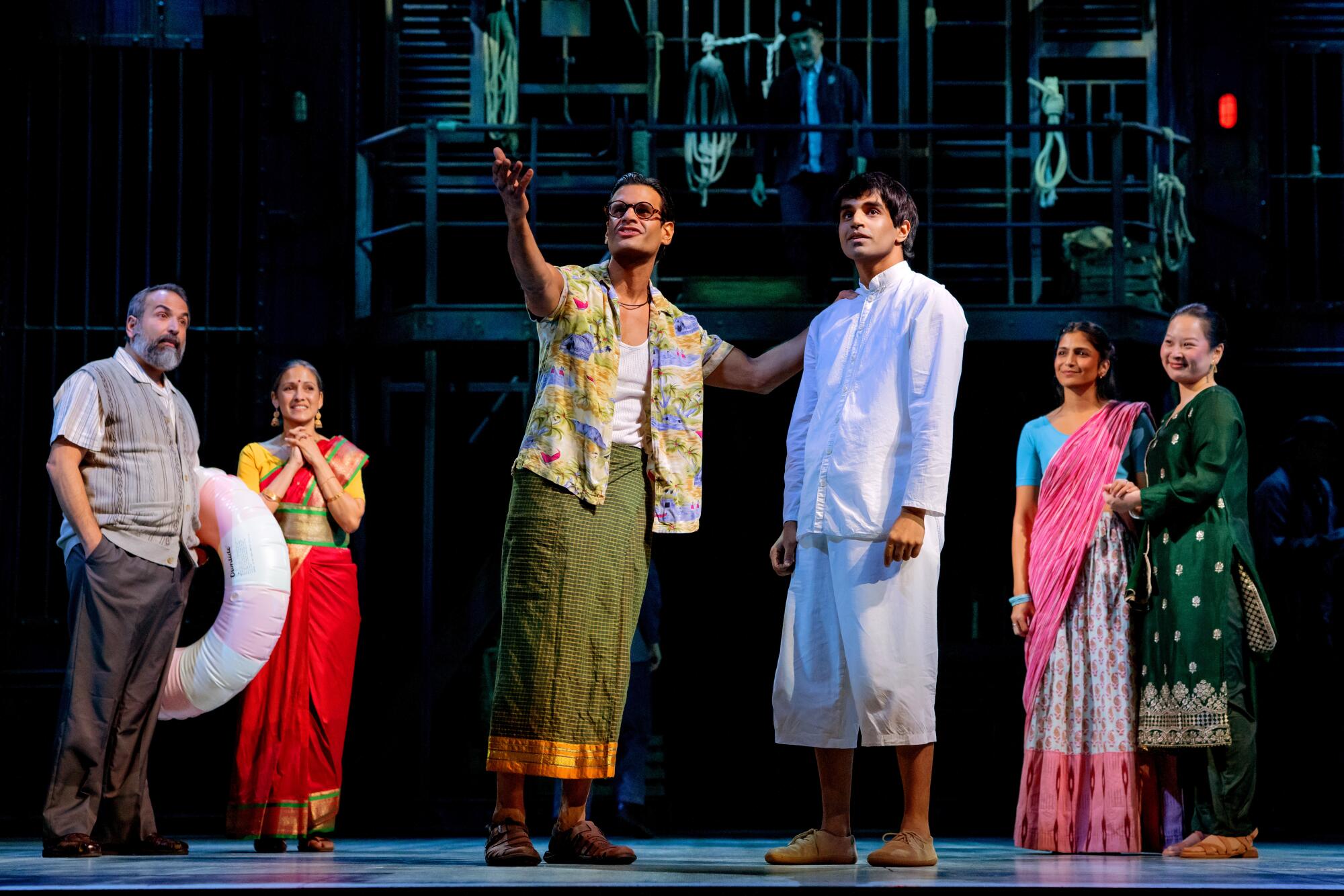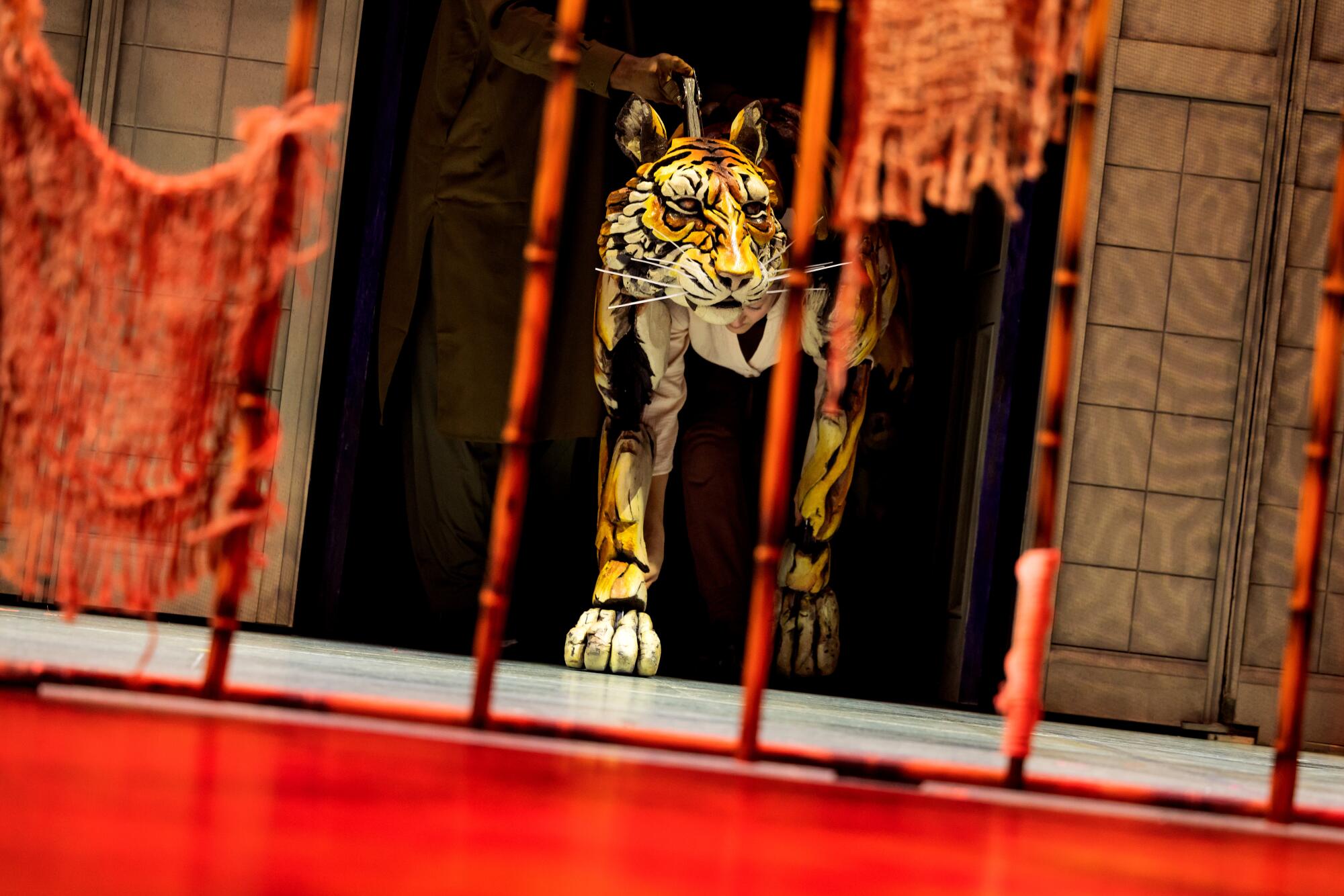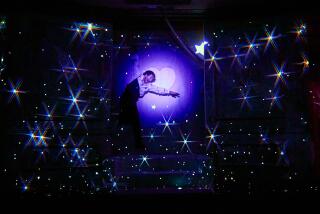
Yann Martel’s 2002 novel, also made into a 2012 Ang Lee film, gets a stage adaptation that is wondrously dreamy and profound. As the tale’s shipwrecked teen, Taha Mandviwala is mesmerizing.
- Share via
The natural world is aswirl in “Life of Pi,” a marvelously inventive stage adaptation of Yann Martel’s 2002 Booker Prize-winning novel. This pageant of puppetry includes a flutter of butterflies, a goat with a plaintive bleat, a menagerie of wild animals and, at one point, a school of glowing fish.
Rather than try to compete with the technological thrills of the 2012 film that earned director Ang Lee an Academy Award, this national tour of “Life of Pi” succeeds through magical simplicity. My senses were dazzled when I first saw the show on Broadway in 2023, but my heart was completely won over at the Ahmanson Theatre, where this production opened on Wednesday.

The story revolves around the survival at sea of a 17-year-old boy named Pi Patel (a mesmerizing Taha Mandviwala) after the Japanese cargo ship transporting his family sinks en route to Canada. The souls lost on board include Pi’s zookeeper father’s fantastical collection of animals. In a lifeboat with barely any supplies for 227 days, Pi somehow manages to escape the fate that leaves his parents, sister and most (but not all) of his bestial companions at the bottom of the Pacific Ocean.
‘Maybe Happy Ending,’ ‘Dead Outlaw,’ Cole Escola’s ‘Oh, Mary!’ and ‘John Proctor Is the Villain’ lead the competition for best musical and best play, with Audra McDonald in ‘Gypsy’ and Nicole Scherzinger in ‘Sunset Blvd’ contending for lead actress in a musical.
How did he pull off the miracle? That is the question posed at the start of Lolita Chakrabarti’s adaptation by two visitors to Pi’s hospital room: Mr. Okamoto (Alan Ariano) from the Japanese Ministry of Transport and Lulu Chen (Mi Kang), from the Canadian Embassy, both of whom have traveled to Mexico, where the boy was washed ashore.
Pi, whose mathematical name is derived from Piscine, the French word for swimming pool, is recovering from his near-death journey. Mr. Okamoto, charged with preparing an official report, is determined to find out the exact circumstances of the shipwreck. But Pi is only able to relate the fanciful version of events that allowed him to survive for so long at sea without food or drinkable water.

The staging transitions in dreamlike fashion from the hospital to Pondicherry, India, where Pi grew up in a happy, hectic ferment of adolescence. Chakrabarti turns Pi’s teasing older brother, Ravi, in the novel into an older sister named Rani (Sharayu Mahale), a math whiz, in the play. The institutional medical setting becomes the background for a tale that doesn’t finely distinguish between memory and imagination, one realm bleeding freely into the next.
Fortunately, the scenic design of Tim Hatley, who also did the costumes, isn’t bound by the traditional laws of physics. The perfectly adjudged video and animation design of Andrzej Goulding, the magnificent lighting of Tim Lutkin and Tim Deiling and the propulsive sound of Carolyn Downing puts time and space under the able command of director Max Webster.
Pi’s family is moving to escape an increasingly chaotic society. “This government shows us bad behavior has no consequences,” Pi’s father (Sorab Wadia) laments to his wife (Jessica Angleskhan), in a line that lands differently today than it did two years ago on Broadway.

When the opportunity to relocate to Canada arrives, the choice is obvious but no less painful for being so. The animals, having no one else to care for them, will have to emigrate too, transforming the cargo vessel into a modern-day Noah’s Ark.
An orangutan named Orange Juice, a hyena beyond the reach of human feeling and, crucially, a royal Bengal tiger with an imperious mien named Richard Parker have prominent roles in Pi’s recollection of his harrowing voyage after the shipwreck. These animals, the creation of inspired puppet designer Nick Barnes and Finn Caldwell, are fluidly deployed by a team of graceful puppeteers, who preserve the essential dignity of these creatures without effacing their ferocity.
The sight of Richard Parker, a growling behemoth of musculature and whiskers, is the most fearsome. Pi, who feels at one with the natural world, has to be taught to be afraid of a creature that could end his life with a single swipe of his claw. (The harsh lesson, administered by his father, reaffirms Lord Tennyson’s image of nature as “red in tooth and claw.”)

Although raised Hindu, Pi partakes of religious services from many sects. His mother is bemused to hear that her son attended mosque, temple and church on the same day. There’s a holy fool quality to the boy, who is the subject of teasing. But Pi is precociously enlightened, his innocence not a problem to be rectified but a quality to be reverenced.
In New York, Chakrabarti’s book struck me as clumsy in places, particularly in the first act. But I had no such misgiving at the Ahmanson, whether because of some slight editing or perhaps just a smoother handling of the setup moments.
Some might resist the work’s spiritual earnestness, but I’d say it’s an ideal time to consider more deeply our belief system. If “Life of Pi” has a moral to impart, it’s that what we choose to believe has as profound an effect on our experience of reality as what we rationally know to be true.

The play, following the novel’s lead, is a parable of overcoming. Pi confronts tragedy but refuses to lose what gives his life meaning. He makes sacrifices that he never thought he’d have to make. A devout vegetarian, he is forced to capture and kill a swimming turtle, then share the meat and blood with Richard Parker, a carnivore without conscience.
“Life of Pi” doesn’t dwell on the deaths of Pi’s loved ones. A cloak of magical realism is thrown over aspects of the story that might prove too disturbing. But the inexorable facts of mortality are glimpsed in the way the animals are depicted onstage.
a.k. payne’s ‘Furlough’s Paradise,’ winner of the 2025 Susan Smith Blackburn Prize, opens at the Geffen Playhouse under the direction of Tinashe Kajese-Bolden.
As hunger overtakes Pi and Richard Parker, the tiger’s skeleton starts to call attention to itself. The turtle is devoured before our eyes in a way that, while cheekily theatricalized, doesn’t leave any doubt that the price of this meal is murder.

But the darkness of the tale helps us see the shimmering beauty of the universe that keeps Pi from succumbing to a watery grave. The stage transforms into a planetarium of wonder. Are the meerkats that appear near the end of the story real or a hallucination? What difference does it make when Pi sees them as clearly as he holds a conversation with Richard Parker?
When he finally offers Mr. Okamoto a starker account of what happened to him, a chronicle affirming his father’s long-held view that man is the most dangerous animal of all, the lesson of “Life of Pi” is thrown into stark relief: Truth is not necessarily the same thing as wisdom.
Mandviwala’s performance as Pi makes this adventure tale both exhilarating and emotionally profound. In circumnavigating distant seas, this majestic production recovers some lost treasure of childhood.
'Life of Pi'
LOS ANGELES
Where: Ahmanson Theatre, 135 N. Grand Ave.
When: 8 p.m. Tuesdays-Fridays, 2 and 8 p.m. Saturdays, 1 and 6:30 p.m. Sundays; ends June 1
Tickets: Start at $40.25
Contact: (213) 628-2772 or CenterTheatreGroup.org
Running time: 2 hours, 10 minutes (one intermission)
*. *. *
COSTA MESA
Where: Segerstrom Hall, Segerstrom Center for the Arts, 600 Town Center Drive
When: 7:30 p.m. Tuesday-Fridays, 2 and 7:30 p.m. Saturdays, 1 and 6:30 p.m. Sundays, June 3-15
Tickets: Start at $44.07
Contact: (714) 556-2787 or SCFTA.org
More to Read
The biggest entertainment stories
Get our big stories about Hollywood, film, television, music, arts, culture and more right in your inbox as soon as they publish.
You may occasionally receive promotional content from the Los Angeles Times.













